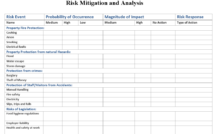Vendor Assessment Template
The vendor assessment template is a change management tool used in business management and educational institutes. Basically, it is a process that business organizations can use to ascertain if prospective vendors and suppliers are meeting the organizational standard and commitments once under contract. The goal is to find a low-risk supplier or vendor as well as to keep an eye on the vendors. While performing this process, you find out the potent risks while working with a vendor, then you decide whether the rewards of working with them doing profitable are compared to the risks. The decisions are based on the policies, conditions, goals and needs of your organization. Conducting a vendor assessment is a long and hectic process, but not conducting it can lead to loss of business, legal fines and damage to your reputation.
How to Conduct a Vendor Assessment?
The following are the steps which anyone can use to prepare his/her own vendor assessment:
Step 1: Types of Risk Elements:
Before you begin to assess the vendors, you need to know different types of risks that you could face in the future. Neglecting even one of these categories can leave you scrambling if something goes wrong.
• Strategic risk.
• Financial risk.
• Technical risk.
• Resource risk.
• Replacement risk.
Step 2: Ascertain Risk Criteria:
After you know all the possible categories of risk, it’s time to develop risk criteria. This depends on the type of business you are conducting with the vendors. To avoid any type of trouble in the future and find the vendor that best fits you, assess vendors consistently. Don’t teach them fast just because you know someone who works there.
Step 3: Assess each Product and Service:
It is important to evaluate both the company you are getting service from and what type of products they are providing you. This gives you a full picture of the potential risk. This helps you to decide whether you want to start or continue a business relationship with them.
Step 4: Use Experts’ Advice:
It is possible that you aren’t an expert in every type of vendor risk. So, to get a full picture of what type of risk you can face, you need to have great knowledge of this matter. Therefore, gaining knowledge from other departments of your organization or even external help is very useful. In this way, you can assess a vendor’s potential risk at a deeper and better level.
Step 5: Assess Every Vendor:
Assessing every vendor, no matter if they provide a big or small service, is an important step. This step should be done before you go into partnership with them. Avoiding this step can be a big risk for your organization.
Step 6: Divide Vendors by Risk Level:
After assessing the vendors, it’s time for you to separate each vendor by level of risk. Separating them can help you decide whether you want to work with them and spend up the risk management planning process if so.
Step 7: Create a Risk Management Plan:
Once it’s decided with which vendor you want to work, you have determined their risk level. It’s time for you to create a risk management plan. Make a plan of how you will manage the risk and work with the vendors properly.
Templates for Vendor Assessment:
Recent Posts
Sales Invoice Template
A sales invoice template is used to create quality invoice templates which a user can use to design their own invoices, whether in a hard copy or soft copy. Mostly, it is prepared by the seller or any other nominated party, when selling the product or inventory to a regular… Read More
Service Invoice Template
The service invoice template is a legal document that is used when a business or an individual is providing services against a fee. It is equipped with the detailed billing information of the client who is receiving your services. A service invoice features the full details of the billing transactions… Read More
Medical Invoice Template
A medical invoice template is a professional document which businesses linked to the medical sector frequently use. In certain cases, a licensed medical practitioner can issue this invoice when selling medical equipment to a medical center, hospital, clinic or to a doctor. Basically, this invoice asks the buyer to make… Read More
Purchase Invoice Template
A purchase invoice template is a computer generated slip which can be used in soft copy as well as in the form of hard copy. Usually, it is provided by a seller to the buyer, describing the list of goods, products or services including the size and color of what… Read More
Tax Invoice Format
A tax invoice format is a legal and highly professional document which is issued by the registered business vendor to a registered purchaser, no matter whether it is in soft copy or in hard copy. Basically, there are two main types of any invoice; one is the tax invoice and… Read More
Blank Invoice Template
A blank invoice template is a highly professional computer-generated invoice either in hard or soft form, by the seller or any other nominated party, upon the request of a regular or a prospective buyer. This invoice helps you with managing all your business documents where you are required to record… Read More

